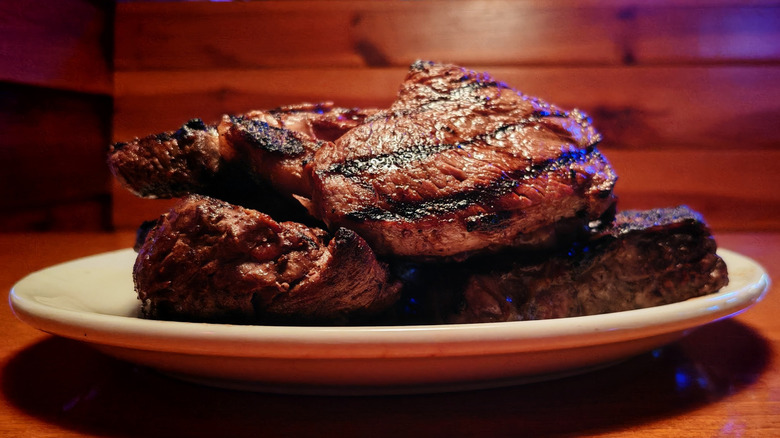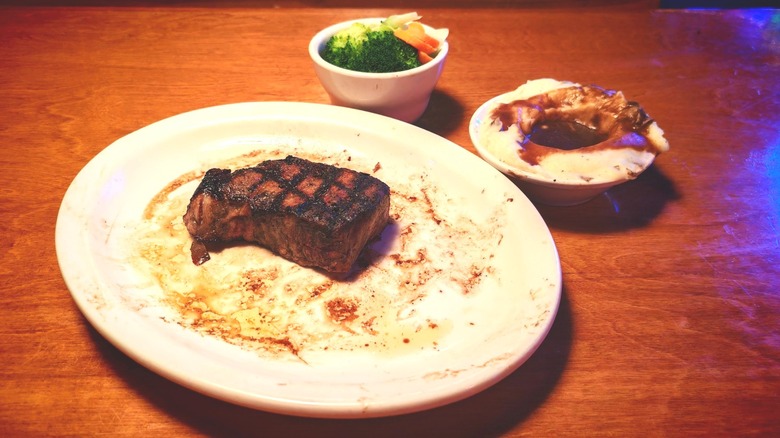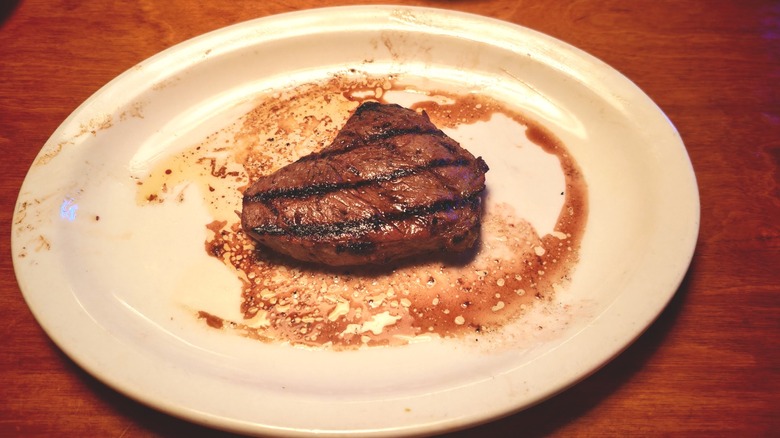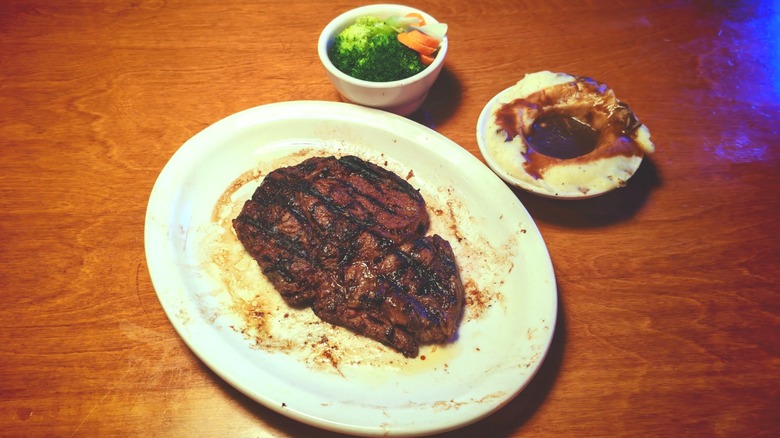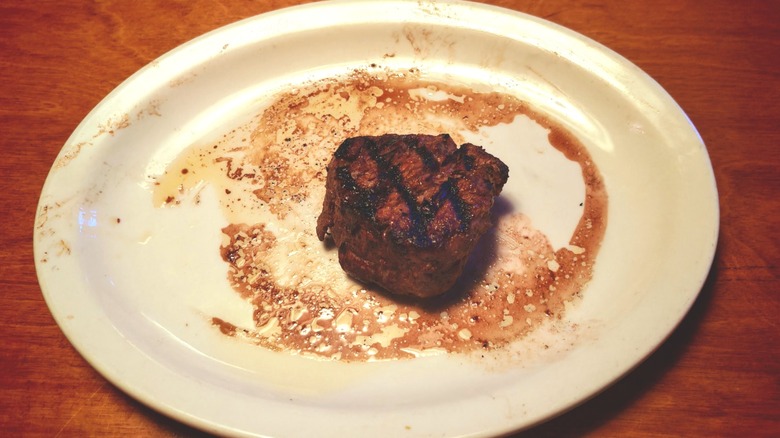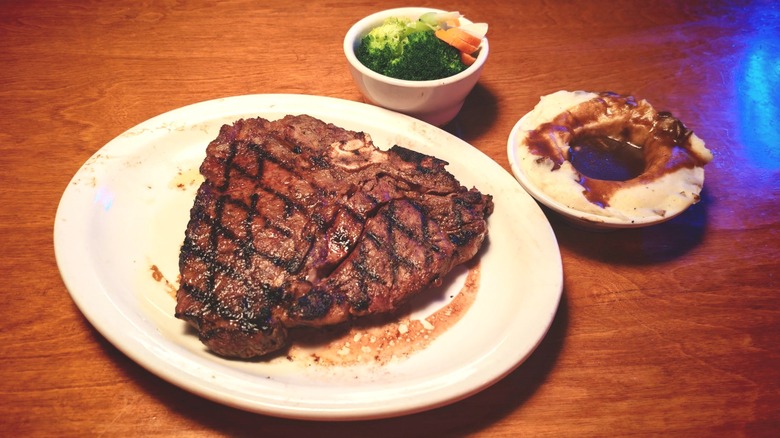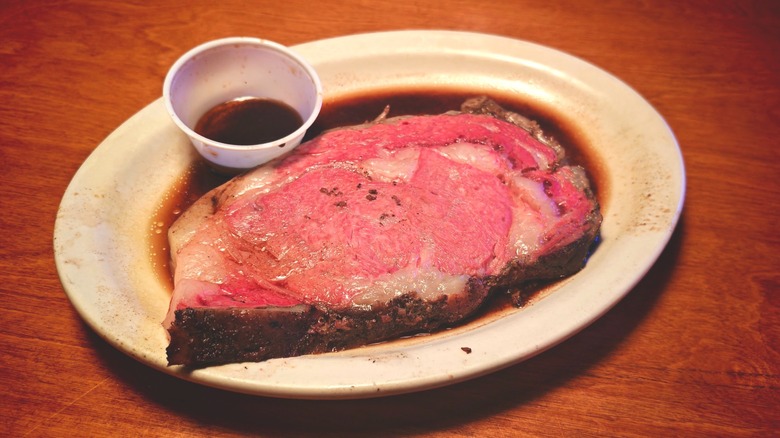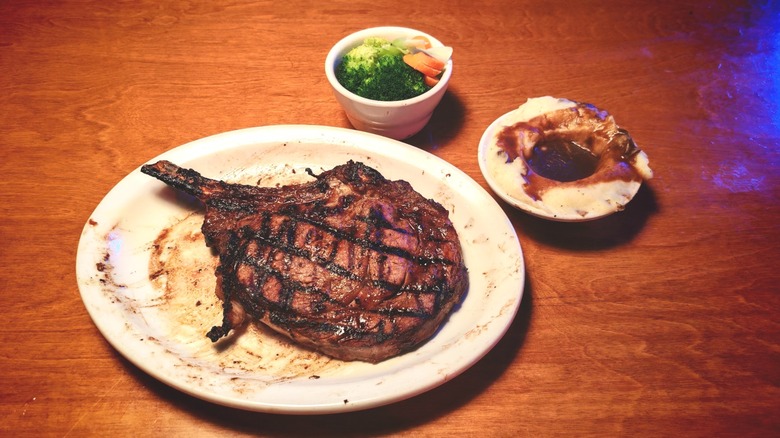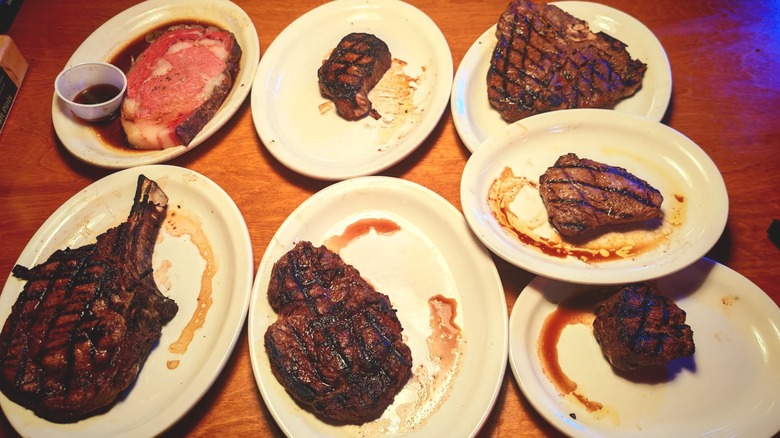The Ultimate Ranking Of Texas Roadhouse Steaks
When you head to a steakhouse, you may feel spoiled for choice. Do you want something rich like a ribeye? Or a lean option like a filet mignon? Do you want your steak on the bone or served neatly trimmed? Popular steakhouse chain Texas Roadhouse has plenty of options, and, after ordering and trying all of them, I've compiled a ranking from worst to best.
The steaks range in size from a small 6-ounce cut to a large 24 ounces, and I ordered the standard size of each. You can also custom-order your steaks if you'd prefer a thicker cut. Each meal comes with a choice of two sides, as well.
When ranking the steaks at Texas Roadhouse, I took several factors in account, with the main ones being taste and texture. There's more info on my methodology and the end. So now that the peanut dust has settled, let's take a look at how the steak options at Texas Roadhouse stack up.
7. 8-ounce New York Strip
The New York Strip was definitely the most disappointing steak of the bunch. The cut I received wasn't a "strip" so much as a "stub." It was pretty short, almost rounded, coming in at about half the length of a regular New York strip. This led me to initially confuse it with the rump, until the cut's distinctive band of fat down one side gave it away.
Given this steak's iconic status, it's a standard at many locations, but the presentation at Texas Roadhouse was a bit of a letdown. The texture and flavor, however, were still there to some degree. As with some of the leaner cuts, the char was pretty overpowering — forcing its way in early and hanging around for the entire bite. Some beefy flavors made it through, but didn't really stand out.
Texturally, the strip was tender like every other cut I tried at Texas Roadhouse, but is one of the tougher steaks on the list. It's not bad by any means and you won't develop a jaw ache chewing this, but it's way behind the likes of the ribeye. The 8-ounce New York strip steak came in at $19.99, making it one of the more affordable cuts on the menu.
6. 6-ounce Sirloin
The sirloin is an affordable cut from the cow's rear, and is often overlooked in favor of something a bit flashier. It's lean, somewhat small, and won't break the bank. Texas Roadhouse's effort was surprisingly nice. Given the leanness of a sirloin, it's easy to make this cut a bit tough — but I had an easy enough time chewing the steak I ordered. In terms of flavor, it's mainly that charred coating. As the old adage suggests, fat equals flavor, and the leanness of the sirloin means it can't compete with many other cuts in terms of taste.
Despite placing pretty low on the list, I'd argue the sirloin punches well above its weight, even though it comes in at just 6 ounces. It offers great value if you just want some steak and not a full blown celebration dinner. It's also one of the two extremely lean cuts on the menu if you want something with lots of protein and little fat.
The sirloin was one of the most affordable steaks on the menu in terms of total price, costing just under $15. However, if you want something more substantial, better value than this cut can be found elsewhere.
5. 12-ounce Fort Worth ribeye
Also known as a Cowboy steak, the ribeye is a steakhouse go-to for many. This fatty cut from the cow's mid-section offers plenty of tenderness and heaps of flavor when cooked correctly. Texas Roadhouse does a decent job with its ribeye, but one oversight means it doesn't really live up to its full potential.
Firstly, the flavor. You get that intense beefiness coming through early, followed by a fair amount of juiciness from the rendered fat. If you like ribeye for its taste, you're not going to be too disappointed. As with every other steak on the menu, the distinctive charred taste from the grill is present — though the ribeye's initial flavor forces this into the background initially.
So where did the chain go wrong? The cut itself is a little thin, coming in at around half an inch. Thicker cut ribeyes are amongst the juiciest steaks you can buy, and you want to double the thickness of Texas Roadhouse's effort at the very least. As the steaks are hand cut on the premises, you can actually ask for your steak to be cut thicker, which will improve it immensely, though you'll also pay a premium for this. As for the standard menu option, there are other things that clearly outperform this popular steak.
The Fort Worth ribeye was priced at $25.99, though at 12 ounces it's also one of the most substantial steaks on the menu.
4. 6-ounce Dallas filet
Filet mignon is often the most expensive cut on the menu, and for good reason. It's a muscle close to the spine that does little work, so a filet is often as tender as it gets when it comes to steaks.
I'm not exactly sure what's so "Dallas" about the Dallas filet, as it seemed like a pretty standard 6-ounce cut to me. So like the "Fort Worth ribeye" it might just be a way of giving the meat a more "Texas" feel. Though there's a regular filet on the menu too, so who ultimately knows?
In terms of flavor, it's stronger than other lean cuts like the sirloin. This is likely due to its thickness, coming in at more than an inch high. This means the meat to crust ratio is better. It isn't enough to overpower the smokiness of Texas Roadhouse's standard cooking method, but it does take the edge off to some degree. Overall, the filet is a solid choice, especially if tenderness is your prime concern or if you're searching for something with little fat and a lot of meat.
The Dallas filet is the most expensive cut on the menu, if you're going by price per ounce. The 6-ounce section set me back $24.99.
3. 24-ounce porterhouse
It's fair to describe a porterhouse as a "best of both worlds" cut. You essentially get two classic steaks — a filet and a New York strip — with a bone in between. Said bone contributes to both the steak's aesthetics and its flavor. The cut itself is similar to a T-bone, but a porterhouse traditionally has a larger "filet" portion.
Texas Roadhouse's porterhouse doesn't disappoint, and would make a solid steak for a special occasion. The strip side is rich and beefy, and hits the spot better than the strip option on the menu. The filet side is a little complex, it's more flavorful than the standard filet, which is likely due to being cooked on the bone. It is a little tougher though; not much tougher, but you will notice. It's also a lot thinner, coming in at just over half an inch.
Despite being on the thinner side, the porterhouse is the biggest cut on the menu, coming in at 24 ounces. While some of that is inedible bone, this is a substantial steak that could theoretically serve as a large meal for one or potentially something to split between two people.
In addition to being the largest steak on the menu, the porterhouse was the most expensive. It cost me $35.99 before tax.
2. 12-ounce prime rib
Prime rib is a bit of a fancy dinner staple. It's essentially the same cut as a ribeye, but rather than being sliced off as a steak and grilled, the entire section of cow is roasted then sliced up afterwards. It's traditionally served rare, and that's how it seems to come at Texas Roadhouse. It's also accompanied by a nice little cup of au jus, with more available upon request.
The prime rib was a serious contender for the top spot. Apologies for the cliche, but it genuinely melts in your mouth with the texture perfectly matching the buttery flavors you get from this tremendous bit of beef. The au jus just adds to this, and gives you something to dip those complimentary rolls in afterwards. The standard prime rib is reasonably thick as well, and a thicker slice can be ordered on request — though you may not need it. At 12 ounces, it's already a large chunk of beef.
It's a pretty fatty cut, though the fat is easy to cut around if that isn't your thing. And it's definitely worth the effort. If you don't like your meat rare, then you can likely request the cook adds a bit of sear to it. However, that essentially turns it into an overcooked ribeye, so you should probably just order that instead. The prime rib was priced at $26.99.
1. Bone-in ribeye
The bone-in ribeye is as good as it gets at Texas Roadhouse. It's noticeably thicker than the standard ribeye, which immediately makes for a juicer end product. The bone itself adds a lot of flavor to the meat, resulting in the sort of deep beefy flavor that will keep you coming back for more.
That Texas Roadhouse sear is also present, adding a nice, charred, finish to your flavor journey. However, the initial taste of the meat is so strong with the bone-in ribeye, that the charr is actually less noticeable.
You also get the "wow" factor with the large bone attached to the back side of the steak. It looks like something from "The Flintstones," and will definitely liven up the table during a birthday or anniversary.
It's a 20-ounce cut, making it the second largest steak on the menu, though a good chunk of that is the bone. It's also the second most expensive steak on the menu, but ultimately it's worth every penny. I paid $32.99 for the bone-in ribeye.
How the steaks were judged
This ranking is based on a number of factors, with taste and texture carrying the most weight. A steak that doesn't taste right, or leaves your jaw muscles aching, isn't something to be recommended. Beyond that, price was a strong consideration. The most expensive thing on the menu should be one of the best, but a cheaper cut that punches above its weight deserves credit.
The "wow" factor was also part of the equation. Texas Roadhouse, and similar restaurants, can be go-to spots for special occasions, and if you're celebrating, or just padding out your Instagram, then you want something that looks good on your plate.
Personal preference plays into steak a lot, so the steaks were cooked to a level I see as appropriate for the cut. I wanted to taste each steak at its best. For reference, the prime rib came as it is generally served, the filet was rare, and fattier cuts like the ribeye were cooked medium-rare so the fat had a chance to render.
